Cover image: Kongming, Sleeping Dragon by Gao Yan
Read our other entries: Introduction; The Yellow Scarves Rebellion; Dong Zhuo Takes Control; The Dying Embers of Rebellion; The Rise of Cao Cao; Cao Cao Conquers the North; The Battle of Red Cliffs; How the West was Won; The Fall of Guan Yu
The Death of Cao Cao (220 CE)
Cao Cao had Guan Yu interred at Luoyang, but the the fallen warrior continued to appear to Cao Cao. In addition, the King of Wei found himself haunted in his dreams by vengeful spirits, and wracked with debilitating migraines while awake.
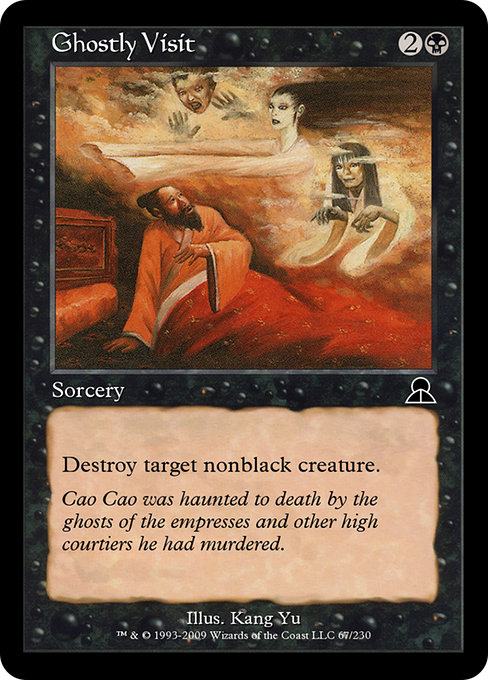
His courtiers summoned Hua Tuo, the legendary physician, to attend Cao Cao. However, because the Honored Physician suggested surgery on Cao’s skull, and had operated on Guan Yu, Cao Cao suspected the doctor would try to kill him, and had him imprisoned and executed. Cao Cao had signed his own death warrant. Increasingly haunted by visions and ghosts, Cao Cao succumbed to his illness; Cao Pi ascended the throne of Wei.
Zhang Fei is Killed (221 CE)
Cao Pi was ambitious like his father, and deposed Emperor Xian, declaring the founding of a new dynasty, called Wei. Liu Bei, angered at the usurpation, responded by declaring himself the emperor of the Han Dynasty, naming Liu Shan his heir, and Kongming his prime minister. However, instead of moving against Wei, Liu Bei, still seeking vengeance for Guan Yu’s death, ordered the invasion of Wu. Leaving his son in Zhuge Liang’s (Kongming’s) care, Liu Bei, Zhang Fei, Huang Zhong, and Zhao Yun (Zilong) prepared to ride east with an army of 750,000 men.
However, Zhang Fei’s alcoholism had gotten out of control, and he became abusive toward his commanders. Fearing further reprisals, they waited until Zhang Fei was passed out in a drunken slumber, and beheaded him, fleeing to Wu in the night.
Liu Bei is Denied Vengeance (222-223 CE)
Sun Quan now feared Liu Bei’s wrath, and sent a messenger to plea for peace, proposing a joint alliance against Wei, offering to return Jingzhou, and return Liu Bei’s wife, Lady Sun, to him. Liu Bei, overcome by his desire for revenge, would hear none of this. Still fearing for his kingdom, Sun Quan then turned to Emperor Cao Pi in Wei, vowing fealty and begging for aid. While Cao Pi accepted Sun Quan’s vow of fealty, and named him king of Wu, he did not send out his forces.
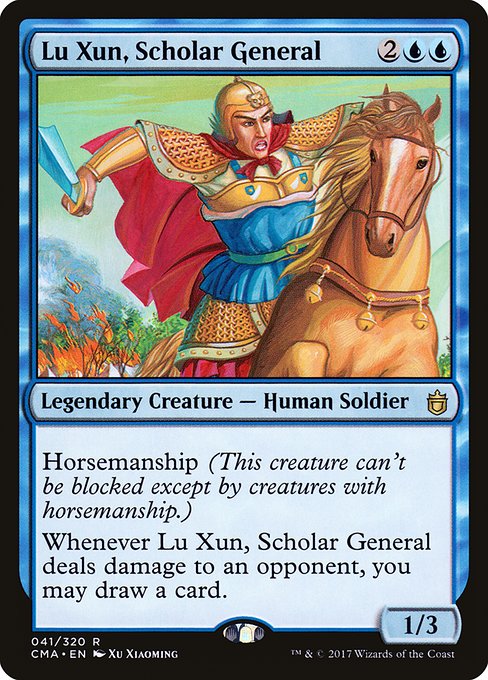
However, Sun Quan had in his employ the savvy Lu Xun, Scholar General. Lu Xun managed to successfully use stealth and fire to rout Liu Bei’s forces, forcing them to flee back to Shu territory. Had it not been for Kongming’s Eightfold Maze—an arrangement of boulders disorienting Lu Xun and his forces, Liu Bei would surely have been captured.
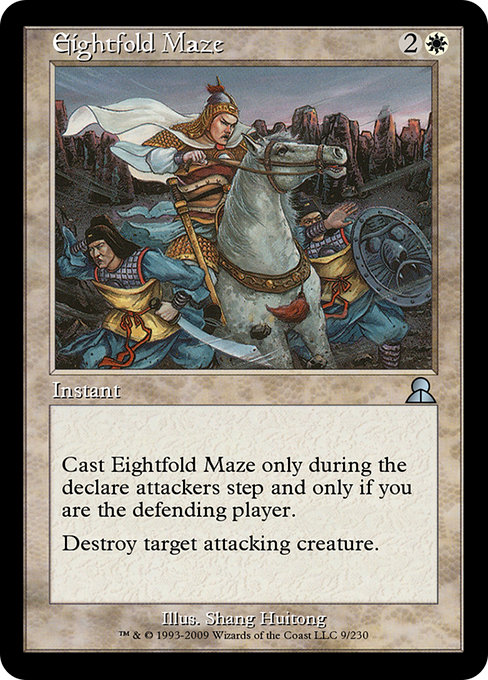
However, Liu Bei became ill after his campaign, and soon died. On his deathbed, he advised Kongming to never trust Ma Su with anything important, and appointed the Sleeping Dragon regent until Liu Shan, around sixteen years of age, could become a capable ruler.
Sleeping Dragon Defends Shu-Han (223-225 CE)
In the wake of Liu Bei’s death, Shu-Han found enemies at its door. However, thanks to Kongming’s expertise, they were effortlessly kept at bay. In addition, the Shu emissary convinced Sun Quan that breaking with Wei and allying with Shu was the surest way to remain in power. Wei spies got word of this, and Cao Pi led an expedition south to secure territory for an invasion of Wu. However, as he approached the city of Guangling, he found it defended by what seemed to be a vast army.
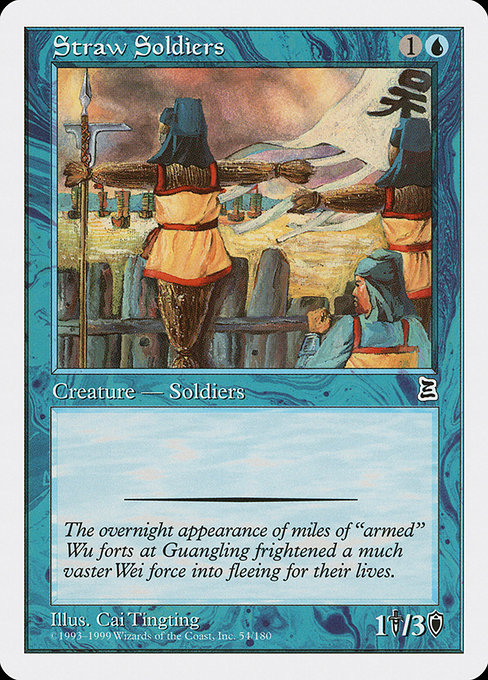
The Wei force panicked at the sight of such a massive army, and news came that Zhao Zilong was attacking the city of Chang’an. Cao Pi decided to flee, but found himself under attack by Wu forces—untold numbers of Wei soldiers perished by drowning in the Yangtze. Pincered by two companies of Wu soldiers, it looked like the end for Cao Pi. Zhang Liao sped to his lord’s defense, but was shot by an arrow in the torso, and the two were rescued by another commander. Zhang Liao succumbed to his wound a few days later.
Against the Nanman (225 CE)
Sensing an opening in Wei’s defenses, Kongming wanted to attack, but found Shu threatened by the “barbarian tribes” (Nanman) of Meng Huo to the south, and sought to make them his allies.
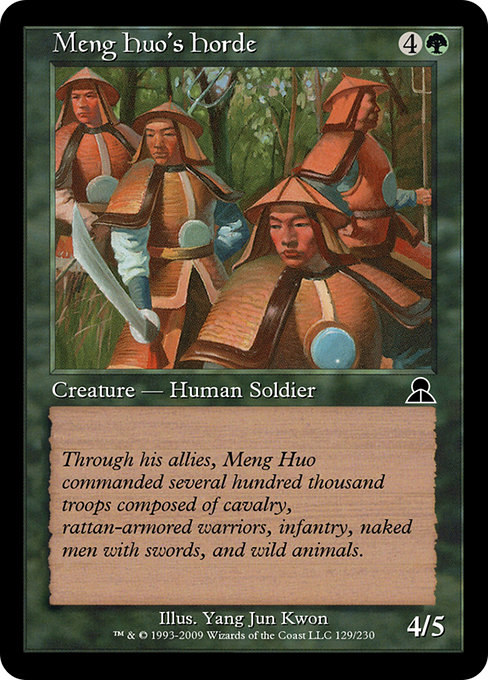
Skillfully dispatching the generals Wei Yan and Zhao Zilong, Kongming succeeded in capturing Meng Huo and his men. But Meng Huo would not submit.
“The whole of the Riverlands once belonged to another. Your lord seized it by force and proclaimed himself emperor. My ancestors held these lands, which you have encroached upon so barbarically.”
“Very well,” said Kongming, “but if I capture you again, will you submit?”
“I shall,” answered the King of the Nanman.
But he did not. Each time, Kongming showed generosity toward Meng Huo, hoping to break his stubborn resolve and win him over. After his fifth capture and release, he sent for the aid of King Mulu, a shaman who commanded fierce animals as well as the elements, but Kongming arrived before King Mulu could. Meng Huo was caught in indecision. Just then, a voice called out, laughing, “A man, and such a fool! I, a woman, will fight them for you!” It was Meng Huo’s wife, Lady Zhurong.
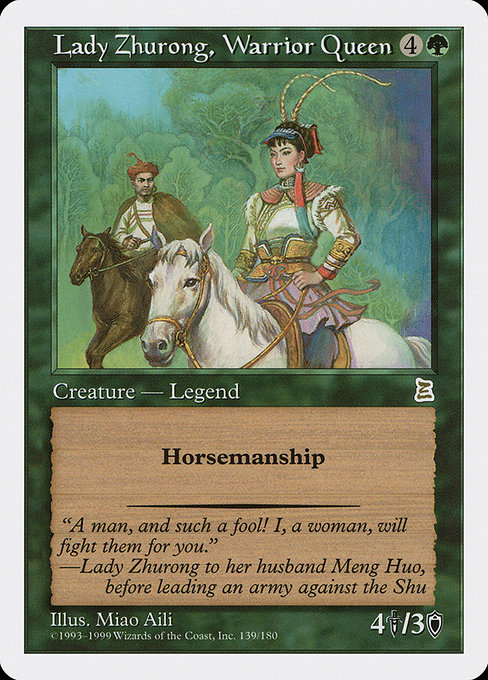
It is said that Lady Zhurong was descended from the legendary fire god, and an expert in throwing knives—never missing her target. Riding on a curly-maned, red-hare horse, Lady Zhurong rode out with a force of 50,000, and captured two of Kongming’s generals in short order.
The next day, Lady Zhurong clashed with Zhao Zilong and Wei Yan, who each feigned defeat to try and lure her into an ambush. She suspected this, however, and would not be baited. However, the following day, the Taunting Challenge of the Shu troops spurred her to anger, and she was captured when her horse stumbled upon a Trip Wire set by Ma Dai. She was returned to Meng Huo in exchange for the commanders she had captured.

Suddenly, King Mulu arrived on his elephant, his army with him, to exact revenge on the forces of Shu. Taking the field, the warrior voiced his incantations, summoning fierce winds that blew sand and pebbles at the Shu forces, like a hard rain. A cacophony or roars and howls came with the wind, and all manner of ferocious beasts charged forth, “riding on the winds, charging, with fangs bared and claws flexed.” Zhao Zilong and Wei Yan were forced to retreat.
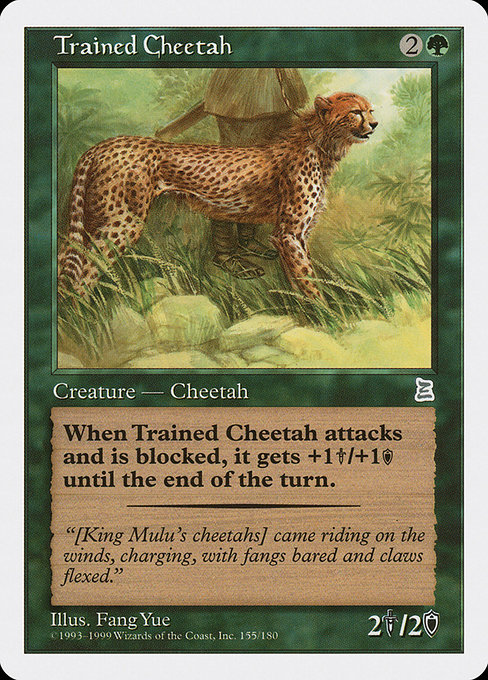
At his base, Kongming reassured them. “I devised some ways of foiling them.” Kongming revealed his inventions: siege machines, built to look like fearsome beasts and capable of belching flame.
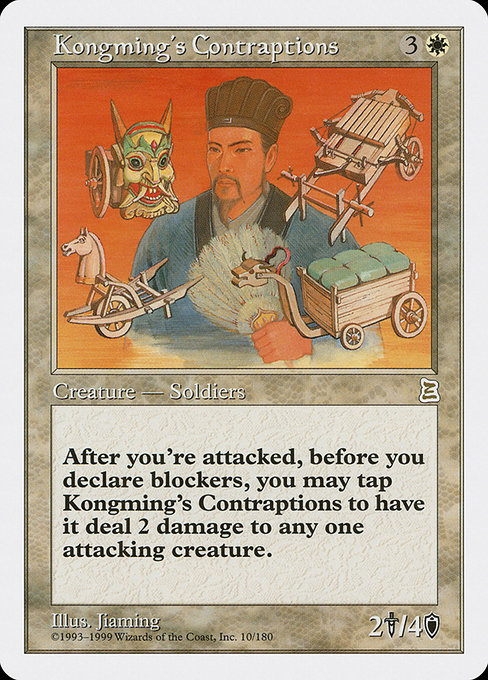
The next day, Kongming met King Mulu in battle. Again King Mulu summoned wind and fierce creatures, but with a wave of Kongming’s feathered fan, the winds reversed direction, and Kongming’s Contraptions, breathing smoke and flame and shaking bronze clangers, took the field. King Mulu’s beasts turned, charging back toward the barbarian horde, trampling many of them as they fled in fear from the machines. King Mulu was killed in the chaos, and Meng Huo and Lady Zhurong were captured yet again. Still, Meng Huo refused to submit, and was released.
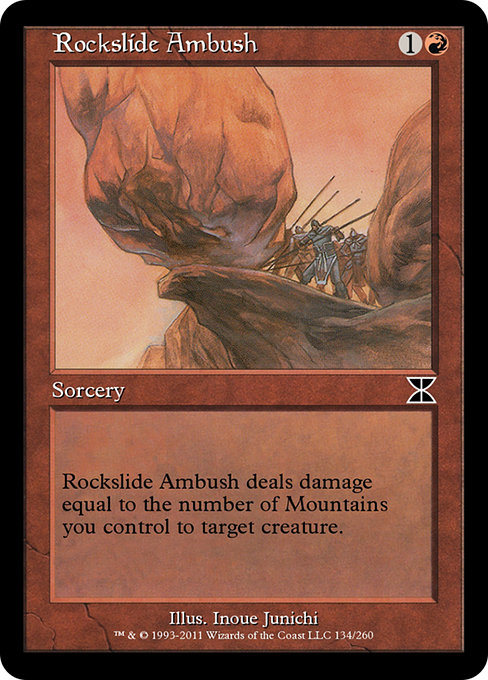
Finally, Meng Huo sought refuge with the Black Lance tribe. Despite Meng Huo’s warnings against Kongming’s favored tactics, the chief of the Black Lance and his soldiers fell into an ambush. Once in the Winding Serpent Valley, Kongming’s forces sealed the passes with a Rockslide Ambush. All around them, the chief of the Black Lances noticed that the pass was packed with black powder and dry tinder. Kongming incinerated the army of the Black Lances.
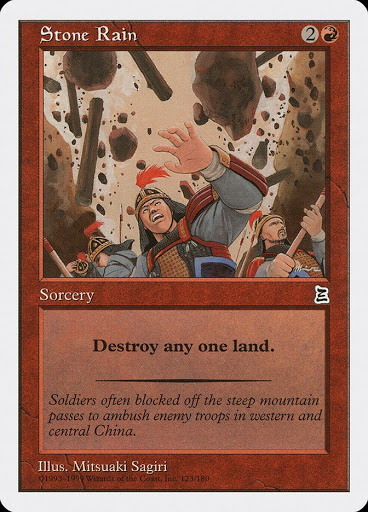
Kongming had emissaries disguised as members of Meng Huo’s Horde send for Meng Huo, under the auspices of needing reinforcements for the Black Lances in their battle in the valley. Meng Huo walked right into Kongming’s trap. Seven times captured, seven times spared, Meng Huo finally agreed to submit to Kongming.
Rather than imposing his rule, Kongming gave Meng Huo back all the territories of Man seized by the Riverlands troops, and made an ally of him, establishing him and Lady Zhurong as rulers of the hollows in perpetuity. In addition, Kongming made sacrifice to appease the spirits that his armies’ passing had angered, “and lo, thousands of ghostly souls, dimly visible, began to clear away” as Kongming made his offering. With the people of Man pacified, Kongming returned to Shu.
Kongming Pushes North (226 CE)
Shortly after Shu’s victory in the South, Kongming got word that Cao Pi had died, advancing Cao Rui to the throne. Seeing an opportunity, Kongming thought it time to finally move against Wei. His initial efforts were wildly successful, capturing three districts, slaying five generals, provoking another to die by heart attack with his words. Cao Rui was becoming anxious. It was then that Cao Rui called on Sima Yi to mobilize forces along the Yellow River. Together with Zhang He, Sima Yi set out to repel the Riverlands armies.
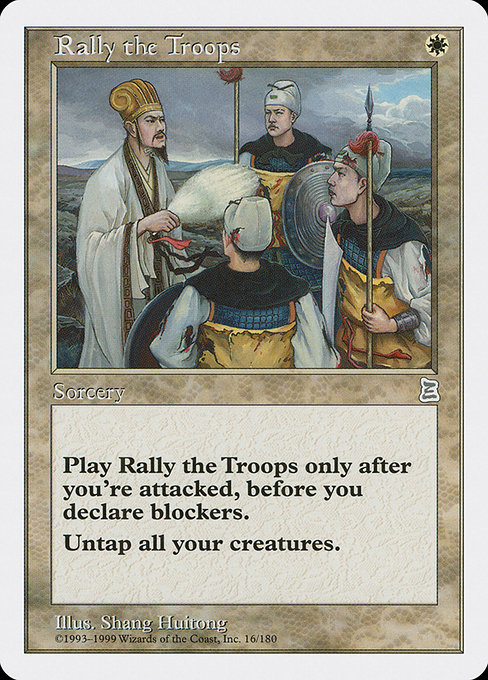
Marching on the crucial village of Jieting, Sima Yi found it guarded by the arrogant Ma Su, who had an inflated sense of his own abilities. Sima Yi cut Ma Su off from the road and from water, and the village was lost with very little effort by Wei forces.
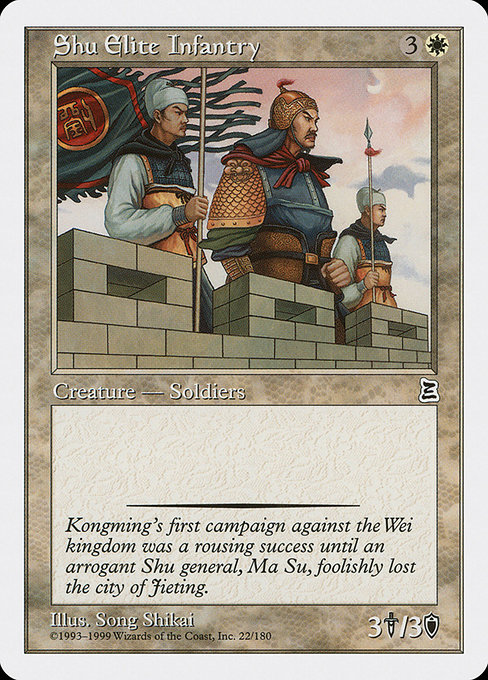
The loss of such an important passageway in Jieting meant the end to Kongming’s expedition, and he ordered his main force to return to Shu while he himself went to Xicheng with 5,000 troops to transport grain.
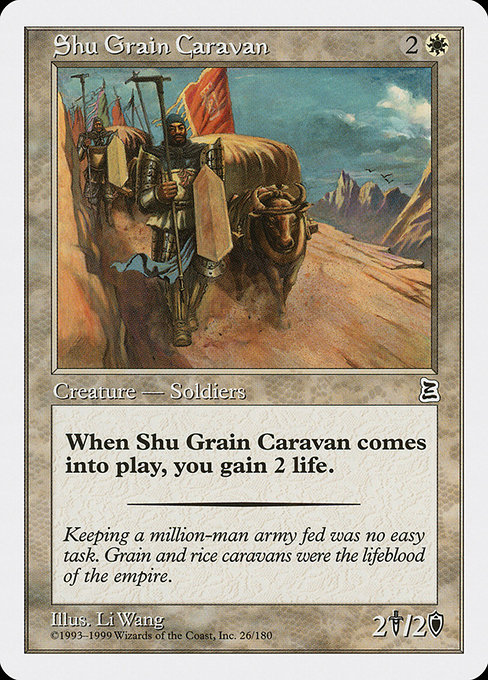
At Xicheng, Kongming received word that Sima Yi was heading toward the city with an army of 150,000. Having ordered half of his 5,000 troops to move grain, Kongming found himself in a city with only 2,500 soldiers. Having no time to imagine a way to defeat such a massive force, Kongming ordered all banners and flags put out of sight, opened wide every gate, disguised his soldiers as common folk, and sat down on the wall with his zither and some incense, waiting for Sima Yi and his army.
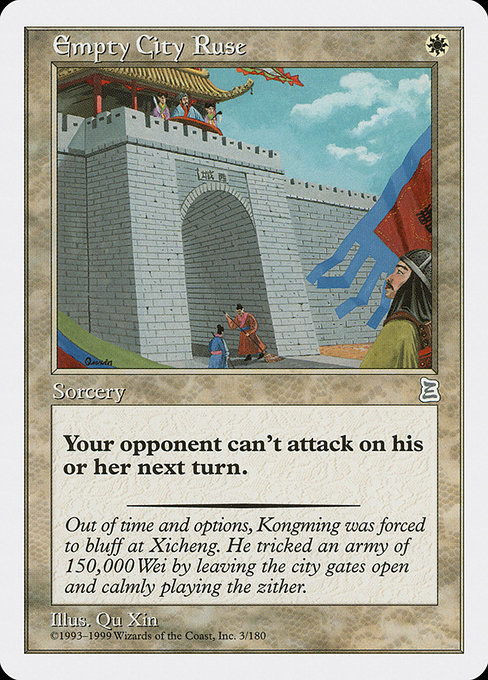
Assuming Kongming was too cautious to tempt fate, Sima Yi suspected an ambush, and withdrew. Once it was safe for him to flee, Kongming also withdrew to Hanzhong, and executed Ma Su for his hubris and failure. Angry at himself for ignoring the late Liu Bei’s advice never to give Ma Su any real responsibility, and for losing all that he had gained, Kongming asked Liu Shan to demote him. Second Emperor Liu Shan agreed, demoting Kongming in title but preserving his duties.
What Was Not in the Cards
This week, I’m most interested in making changes to existing cards, and maybe giving some existing cards the “Godzilla-alt-name” treatment. First, Kongming’s Contraptions are works of artifice. They can stay mono-white, but let’s make them artifact creatures.
Secondly, Lady Zhurong, Warrior Queen deserves far better: a descendant of the fire god who never misses with her throwing knives, excellent with her spear, and not easily tricked? At five mana, a 4/3 horsemanship can probably still hold another ability: let’s say green’s one-sided fight mechanic, approximate either the reach of her spear or her throwing knives. “When Lady Zhurong, Warrior Queen enters the battlefield, she deals damage equal to her power to target creature an opponent controls.”
I do have one design however, that I’d like to add: King Mulu. Mulu only appears in one chapter, dying after Kongming causes his animals to turn back on him. However, his role in two battles leaves an impression, and if Kongming’s Contraptions (used to defeat King Mulu) can have a card, the master of Bana Hollow should have one as well. King Mulu makes use of elephants, wolves, cheetahs, and so on, so it would seem appropriate if on entering the battlefield, he created tokens.
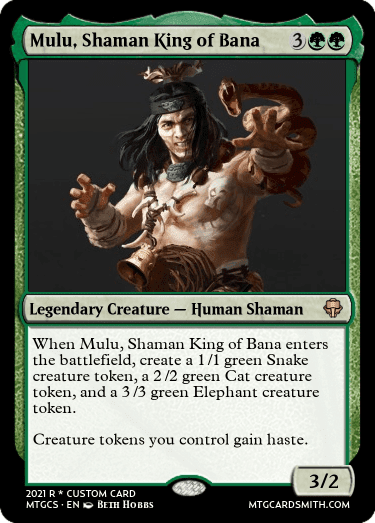
Mulu is essentially Bestial Menace on a 3/2 body that grants haste to tokens. (In fact, let’s consider adding Bestial Menace to the card pool for our hypothetical set remaster.) His abilities are strong, but green cards are pushed these days. What do you think: Is this too much for a five-mana rare in green?
Read On!
This week, the death of almost all the previous generations’ heroes has shifted the focus of the novel to the rivalry between Kongming and Sima Yi, with Kongming becoming the new “hero” in Liu Bei’s place. Kongming initially shines as a strategist, as he always has, pacifying the southern tribes with the Confucian principle of “convincing others by virtue,” and holding off the Wei forces to the north.
However, he begins to stumble when he tries to expand, as almost all of Shu’s expertise has now died in battle or from illness, and few of his young commanders match the old generation in valor or intelligence. Can Kongming turn the kingdom of Shu around and complete his plan to restore the Han? Or will Sima Yi prevail? And what will become of Sun Quan’s kingdom of Wu? Read on!
Recommended Media
Luo Guanzhong, Three Kingdoms (trans. Roberts, 1991), Ch. 78-97 (pp. 590-744).
Zhang Qirong & Li Chengli, Romance of the Three Kingdoms (Asiapac Comic Series: 1995/2006), Vol. 8.
Cool History Bros, Romance of the Three Kingdoms—EP5: Three Kingdoms Established (Summarized).
Jacob Torbeck is a researcher and instructor of theology and ethics. He hails from Chicago, IL, and loves playing Commander and pre-modern cubes.

